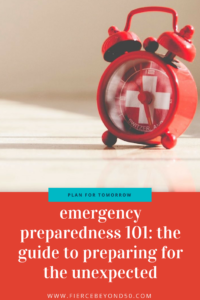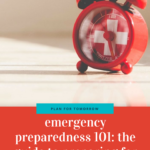This post may contain affiliate links. Full disclosure policy
THIS POST MAY CONTAIN REFERRAL LINKS. IF YOU CLICK THROUGH AND TAKE ACTION, I MAY BE COMPENSATED, AT NO ADDITIONAL COST TO YOU.
A lot of people’s idea of emergency preparedness amounts to hoping it won’t happen, not to them.
Until fairly recently, I was one of those people.
Sure, I understood that emergencies and natural disasters can happen. Having served as a translator for a medical mission in the wake of a hurricane in Mexico, I had firsthand knowledge of the devastating impact of natural disasters. I also understood that the impact is even more devastating for people who are unprepared.
Still, though I understood that disasters can happen, I couldn’t quite make myself think they could happen to us.
When I did allow myself to contemplate the possibilities of natural disaster, I would quickly tap into my inner Scarlett O’Hara. I would think about it tomorrow.
Somehow, tomorrow never came. Sound familiar?
But whenever I’d turn on the TV and see news of flood, fire, famine, or earthquakes, those worries would pop back into my mind. I knew I should do something about them. But what? I had no idea where to begin.
Last summer, I moved to Central Oregon. This beautiful region has great weather, clear lakes, exquisite scenery, and abundant forests. It’s pretty darned close to paradise. The only drawback is that, every year, some of those forests burn.
I couldn’t put it off any longer. It was time to prepare.
HOW PREPARED IS PREPARED ENOUGH?
If you do an online search about emergency preparedness, you’re going to quickly come across some stuff that, at least to me, seems pretty out there.
I’m not saying that a global thermonuclear war isn’t a possibility. I’m just saying that, if it comes down to that, I’d just as soon go in the first strike. Hanging out in an underground bunker for years and surviving on canned anchovies is an experience I’d just as soon skip.
If the Internet is correct, there are plenty of people who are all over the bunker approach. If that’s your thing, fine. I’m not judging. But, for me, it feels a little extreme.
There are other people out there who seem think there’s really nothing you can do about disasters. Stuff happens. You just have to hope it won’t happen to you. Not surprisingly, their approach is to do nothing.
This feels a little extreme to me as well, just in the opposite direction. After all, not every disaster involves global annihilation. (In fact, so far, none of them do.) But wildfires, floods, tornados, and good old-fashioned power outages happen.
Those, you can do something about. So why wouldn’t you? It only makes sense, right?
That’s the approach I chose for myself and my family; one of sensible precaution. I can’t be prepared for every possible emergency, but I can be prepared for most of them.
So can you.
REMEDIAL EMERGENCY PREPAREDNESS
Before we even get to Emergency Preparedness 101, let’s take a step back and make sure you’re prepared for smaller (and far more common) personal emergencies.
If you were in an accident, became ill, or were out of the country when an unexpected disaster struck, you might feel stunned or confused. You and your family should always carry an emergency contact form in your wallet.
The Red Cross has a free, online card you can print out and home and fill in for yourself.
It includes basic contact information and gives space for you to list important numbers you might want to have in an emergency. Mine includes phone numbers for several family members as well as my insurance agent.
Also, I’ve written out the location where our family is to meet in the event of an emergency. Be sure to have that conversation in advance. Print out a card for every member of your family and make sure to keep them updated.
Chances are, you’ll never need them. But if you ever do, you’ll be glad you have them.
THE LIKELY SCENARIOS
The first step in Emergency Preparedness 101 is to consider what kinds of emergencies you might realistically face.
Living in Central Oregon, a couple hundred miles from the coast, hurricanes aren’t really something I need to worry about.
But forest fires are a very real concern, and probably the mostly likely scenario I would face. But winter storms with ensuing power outages run a close second. Another less likely scenario is an earthquake.
A sensible precaution dictates that I prepare for all of these possibilities. However, depending on the scenario, I might need to respond in two different ways.
PREPARED SHELTER IN PLACE
In a number of emergency situations, you might need to shelter in place, possibly without access to power or running water, for days or even weeks at a time.
When I began working to prepare my family for a shelter in place emergency, my first step goal was to pull together two 72-hour emergency kits – one for our home and one for the car. Over time, I added to our home kit until we had supplies for two weeks.
So what do you need to shelter in place?
Food, water, and first aid supplies top the list. You can find a specific list items for your kit here.
The biggest concern is water. You’ll need a minimum one-gallon per person, per day. A two-week supply of water is heavy – one gallon of water weights more than 8 pounds – and can take up a lot of room. Even so, don’t skimp on water. It’s vitally important.
Old milk or soda jugs can be used for water storage but you need to clean the bottles thoroughly before filling.
Make a solution of one teaspoon of household bleach to one gallon. Fill your storage container with the solution and let it sit for about 3 minutes. Then pour out the solution and fill with tap water. Every six months, pour out the old water, clean the jugs again, and refill them.
Larger amounts of water can be stored heavy-duty plastic, BPA free containers. I like these AquaBrick containers. They hold about 2.5 gallons each, weight 20 pounds filled, and stack for easier storage.
PREPARED TO EVACUATE
No matter where you live, you should prepare an evacuation plan in advance.
Imagine that you had 15 minutes notice to evacuate your home, or an hour. What would you absolutely need to take with you?
Write a list of the items and then tape it to the inside of a kitchen cabinet. In a real emergency, you would likely be flustered. Having a list prepared in advance will ensure that you don’t forget anything important.
Also, make copies of important papers, credit cards, deeds, bank account numbers, insurance policies, important legal papers, and phone numbers. Put all those papers into a special folder or notebook, and mark it clearly so you can grab it if you need to leave in a hurry.
Also, make a list of things might need to do before you leave your house. Procedures to prepare your home for evacuation can vary depending on the emergency. But you should know how to turn shut off the gas, pilot lights, and propane tanks.
SAFE AND SENSIBLE
If you’ve never done it before, preparing for an emergency can feel overwhelming. But you can do this! Take it step-by-step and task-by-task.
We can’t be ready for every scenario but with some pre-planning and sensible precaution, you’ll be ready for just about anything.
And that will feel really good. I promise.




